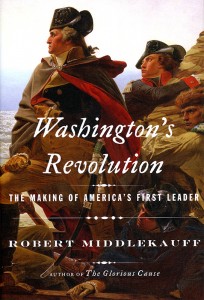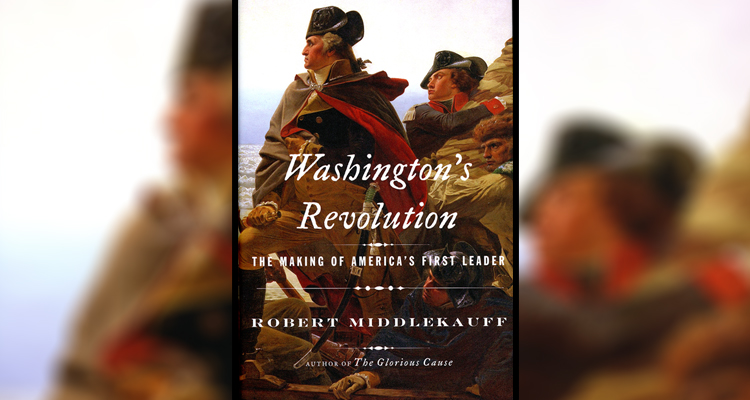 Washington’s Revolution
Washington’s Revolution
The Making of America’s First Leader
By Robert Middlekauff
384 pages. Knopf, 2015. $30.
Reviewed by Edward G. Lengel
HISTORY IS ABOUT CHANGE, but historians struggle to accept this elemental fact when it comes to George Washington. Too often he appears as a monumental figure, immutable as any marble statue. Textbooks depict him as possessed of a number of fixed personal qualities that informed his allegedly steadfast strategic vision during the Revolutionary War. More broadly, he is often said to have seethed with ambition that drove him to seek leadership of the Continental Army in 1775 as avidly as he had striven to distinguish himself on the battlefield as a young man during the French and Indian War.
Historian Robert Middlekauff rejects the traditional narrative in his important new work on Washington’s military leadership during the Revolutionary War. He presents Washington as both the subject and agent of change; as a man who melded and was transformed by the struggle for independence. The French and Indian War, summarized in two brief chapters, revealed the young Virginian’s qualities and shortcomings. It also served to solidify his self-confidence, determination, and sense of personal and military honor. By 1758, Middlekauff argues, Washington had become a seasoned and markedly skillful veteran soldier who showed definite promise as a high-ranking leader.
Washington accepted command of the Continental Army in 1775 with conflicted feelings that combined duty and trepidation. Attempting to construct an effective army outside Boston and uncertain whether the nation could endure over the long term, he looked for opportunities to bring the war to a quick conclusion. Those opportunities proved elusive. Although the British abandoned Boston under pressure, they returned in force the following summer, drubbing Washington at Long Island and forcing him to retreat across New Jersey to Pennsylvania. Middlekauff deftly summarizes these actions and heralds the Continental victories at Trenton and Princeton as events that honed Washington’s still-emerging leadership skills while also transforming the conflict’s nature.
In chronicling the events of the following years, from the Philadelphia campaign of 1777 to the 1778 Battle of Monmouth and the years of promise and frustration that followed, Middlekauff properly highlights Washington’s role as a unifier whose leadership brought focus to a dangerously divided nation. In contrast to other recent historians who have posited British defeat as inevitable, he suggests that patriotic sentiment was far from unshakable and American victory by no means preordained. Washington’s organizational ability underpinned the survival of the Continental Army, which in turn ensured that the American people remained supportive of the cause.
The quest for unity informed both Washington’s conduct during the Yorktown campaign and his vision of a post–Revolutionary America. His ability as a diplomat ensured active French cooperation during the crucial campaign of 1781. At the same time, he became increasingly convinced of the need for a centralized, efficient government to raise national prosperity from the ashes of war. Middlekauff concludes his narrative by highlighting how Washington’s enduring belief in civil supremacy inspired his vision for the future of the United States. This fine work suggests that independence was not a certitude but an astonishing achievement that owed much to a man who, like his country, came to maturity in war.
Edward G. Lengel is the editor in chief of the Papers of George Washington at the University of Virginia. His books on Washington include General George Washington: A Military Life (2005).


.jpg)



